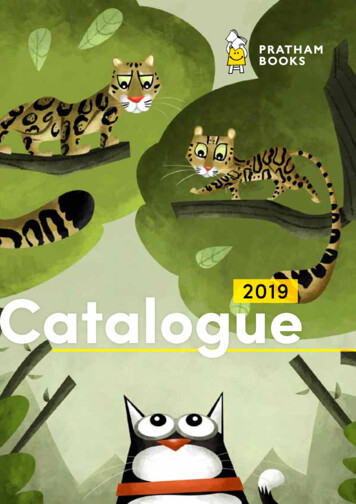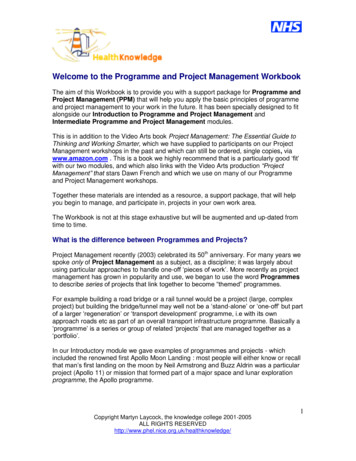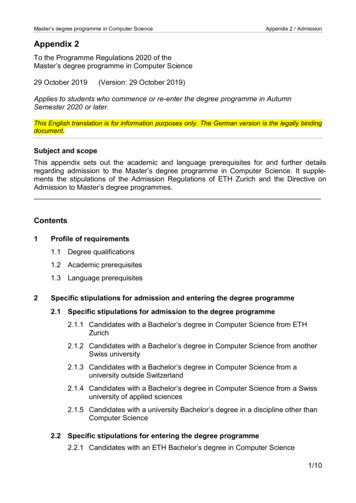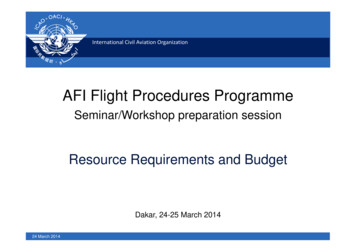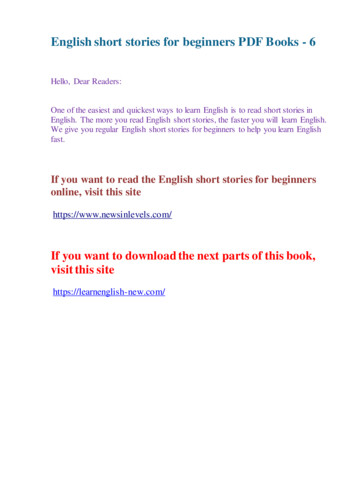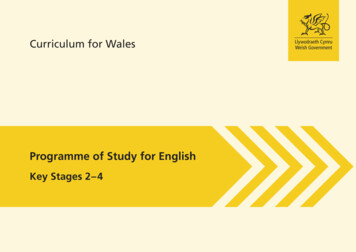
Transcription
Curriculum for WalesProgramme of Study for EnglishKey Stages 2–4
Curriculum for Wales: Programme of Study for English, Key Stages 2–4AudienceTeachers, headteachers and governing bodies of maintained schools in Wales; local authorities; regional consortia; initial teacher training providers; teacher unions and school representative bodies;church diocesan authorities; national bodies in Wales with an interest in education.OverviewThis document sets out the Welsh Government’s requirements for English in the national curriculum for Wales. It is issued pursuant to the powers contained in section 108 of the Education Act 2002and which are vested in the Welsh Ministers. The Welsh Ministers form part of the Welsh Government.Action requiredTeachers, headteachers and governing bodies of maintained schools must ensure that the legal requirements set out in this document are implemented in line with the dates specified in the foreword.Further informationEnquiries about this document should be directed to:Curriculum DivisionDepartment for Education and SkillsWelsh GovernmentCathays ParkCardiffCF10 3NQe-mail: curriculumdivision@wales.gsi.gov.ukAdditional copiesThis document can be accessed from the Welsh Government’s Learning Wales website at www.gov.wales/learningRelated documentsCurriculum for Wales: Programme of Study for Welsh, Key Stages 2–4 (2016); Curriculum for Wales: Programme of Study for Mathematics, Key Stages 2–4 (2015).Mae’r ddogfen yma hefyd ar gael yn Gymraeg.This document is also available in Welsh. Crown copyright 2016WG28587Digital ISBN 978 1 4734 6402 5
ContentsForewordForeword1Key Stage 2 Programme of StudyOracyReadingWritingNational curriculum outcomesNational curriculum level descriptionsAttainment targets2259131314Key Stage 3 Programme of StudyOracyReadingWritingNational curriculum outcomesNational curriculum level descriptionsAttainment targets17172023262627Key Stage 4 Programme of StudyOracyReadingWriting30303336This document sets out the national curriculum for English in Wales.The structure of the national curriculumThe national curriculum applies to learners of compulsory school age in maintained schools. It isorganised on the basis of three key stages, which are broadly as follows*.Learners’ agesYear groupsKey Stage 27–113–6Key Stage 311–147–9Key Stage 414–1610–11In Wales, the following subjects are included in the national curriculum at the key stages shown.Key Stage 2English, Welsh, Welsh second language, mathematics, science,design and technology, information and communication technology,history, geography, art and design, music and physical education.Key Stage 3As at Key Stage 2, plus a modern foreign language.Key Stage 4English, Welsh, Welsh second language, mathematics, science andphysical education.For each subject, in each of the key stages listed above, programmes of study set out whatlearners should be taught.At the end of Key Stages 2 and 3, standards of learners’ performance are set out in eight leveldescriptions of increasing difficulty, with an additional description above Level 8 to help teachersin differentiating Exceptional Performance.At Key Stage 4, external qualifications are the main means of assessing attainment in thenational curriculum. The Database for Approved Qualifications for Wales (DAQW) includes allqualifications that Welsh Government has approved, under section 96 of the Learning and SkillsAct 2000, for use with learners of compulsory school age.Implementation datesThe revised programmes of study for English become legal requirements by means of an Ordermade by the Welsh Government and come into effect on 1 September 2015.From this date the existing national curriculum for English is superseded.Welsh GovernmentAugust 2015* The key stages are defined precisely in section 103 of the Education Act 2002.Page 1 of 39
Key Stage 2 English Programme of StudyStrand: OracyRange of experiencesLearners should be given opportunities to: orally rehearse for writingrespond orally to continuous and non-continuous textssee and hear different people talk, including successful speakers and people with different dialects, and respond to what is being seen and heardincrease their confidence in language use by drawing on their knowledge of English (including standard English), Welsh and other languagesrespond orally to a variety of stimuli and ideas, including written and dynamic texts, e.g. paintings, music, film, still and moving imagescommunicate for a range of purposes, e.g. recount and present information, instruct, argue and explain a point of view, discuss an issue, persuade, question and explore interpretations, convey feelingsspeak and listen individually, in pairs, in groups and as members of a classuse a variety of methods to present ideas, including ICT, dramatic approaches, discussion and debatepresent, talk and perform in formal and informal contexts and for a variety of audiences including teachers, peers, younger/older learners, familiar and unfamiliar adultsengage in activities that focus on words, their derivation, meanings, choice and impactlisten and view attentively, responding to a wide range of communication, e.g. written and dynamic texts, theatre and poetry performance, visiting speakers, explanations, instructionsspeak clearly, using intonation and emphasis appropriately, e.g. recitation, oral storytellinguse appropriate vocabulary suitable for the situation or purposeuse appropriate vocabulary and terminology to discuss, consider and evaluate their own work and that of others, e.g. authors, peers.Learners should experience a language-rich environment across the key stage where oracy, reading and writing experiences are connected.The programmes of study for English and Welsh have been developed side by side. Learners can use translingual and dual literacy skills to develop both languages so that a strength in one language reinforces the other.KeyWithin the table, text taken from the LNF will appear as normal text. Text that is a specific English Programme of Study skill will appear as bold. These skills are further identified by the following icon.Programme of study skill vWhen combined with the LNF statements, these skills form the Key Stage 2 English Programme of Study.N.B.In order to comply with accessibility and legibility, these tables have been designed to be printed at their optimum size of A3.Page 2 of 39
Key Stage 2 English Programme of StudyStrand: OracyYear 3Year 4Year 5Year 6ElementsAspectsLearners are able to:Learners are able to:Learners are able to:Learners are able to:Developingand presentinginformationand ideasSpeakingexplain information and ideas usingrelevant vocabularyexplain information and ideas usingsupportive resources, e.g. on-screen andweb-based materialsexplain information and ideas, exploringand using ways to be convincing,e.g. use of vocabulary, gesture,visual aidsexpress issues and ideas clearly, usingspecialist vocabulary and examplesorganise what they say so that listenerscan understand, e.g. emphasising keypoints, sequencing an explanationorganise talk so that different audiencescan follow what is being said, e.g. givingbackground information, providing abrief summary of main pointsspeak clearly, using formal language andprojecting voice effectively to a largeaudience, e.g. event for parents/carers,presentation to visitorsspeak clearly varying expression to helplistenersadapt talk, showing understanding of thedifferences between informal talk withfriends and more extended talk with awider groupuse language appropriate to more formalsituations, e.g. during an assembly,talking to a visitorKey: Normal text: LNF statementspeak clearly, using formal language,varying expression, tone and volume,to keep listeners interestedbegin to develop their understandingof when it is appropriate to usestandard English and begin to useformal and informal language vdevelop their understanding of whenit is appropriate to use standardEnglish and use formal and informallanguage vunderstand when it is appropriate touse standard English and use formaland informal language vextend their understanding ofthe use of standard English andtheir ability to recognise and useformal and informal languageappropriately vdevelop their ability to use a rangeof syntax structures in terms ofvocabulary and terminology in theirtalk vuse a range of syntax structures,vocabulary and terminology in theirtalk vdevelop their ability to use awide range of syntax structures,vocabulary and terminology in theirtalk vuse a wide range of syntaxstructures, vocabulary andterminology in their talk withprecision vkeep in role and support others inrole playexplore different situations throughrole playexplore issues and themes throughrole playexplore challenging or contentious issuesthrough sustained role playProgramme of study skill vPage 3 of 39
Key Stage 2 English Programme of StudyStrand: OracyYear 3Year 4Year 5Year 6ElementsAspectsLearners are able to:Learners are able to:Learners are able to:Learners are able to:Developingand presentinginformationand ideasListeninglisten carefully and make connectionsbetween what they are learning andwhat they already knowlisten carefully to presentations and showunderstanding of main pointslisten carefully to presentations usingtechniques to remember the main points,e.g. making notes, summarisinglisten carefully to presentations andshow understanding of the speakers’conclusions or opinionscheck understanding by asking relevantquestions or making relevant commentsafter listening, respond, giving views onwhat the speaker has saidlisten to others, asking questions andresponding to both the content and thespeakers’ viewpointsrespond to others with questions andcomments which focus on reasons,implications and next stepscontribute to group discussion, sharingideas and informationcontribute to group discussion and helpeveryone take partcontribute to group discussion, takingsome responsibility for completing thetask well, e.g. introducing relevant ideas,summing upcontribute purposefully to groupdiscussion to achieve agreed outcomesexpress basic opinions about topicsand written texts, e.g. discusstopics that are within their scope ofexperience, discuss a character in astory vexpress opinions about topics andwritten texts, e.g. topics that affecttheir school, what they think aboutthe ending of a story vexpress opinions about topics andwritten texts and include somesupporting reasons vexpress opinions clearly abouttopics and written texts and includesupporting reasons vuse talk purposefully to complete a taskin a group.help a group to reach agreement,e.g. considering reasons orconsequences, keeping focus onthe topic.build on and develop the ideas of othersin group discussions, e.g. by askingquestions to explore further, offeringmore ideas.follow up points in group discussions,showing agreement or disagreementgiving reasons.Collaborationand discussionKey: Normal text: LNF statementProgramme of study skill vPage 4 of 39
Key Stage 2 English Programme of StudyStrand: ReadingRange of experiencesLearners should be given opportunities to: read a wide range of continuous and non-continuous texts, in printed and dynamic format, as a basis for oral and written responses. These should include:–– extracts and complete texts–– information and reference texts–– traditional and contemporary poetry and prose–– classic children’s fiction and poetry–– graphic novels and picture books–– drama, including drama in performance–– texts written by Welsh authors, texts with a Welsh dimension and texts from other cultures–– texts that have challenging subject matter, which broadens perspectives and extends thinking–– texts with a variety of structures, forms, purposes, intended audiences and presentational devices–– texts that demonstrate quality and variety in language use–– texts that reflect individual choice of reading matter–– texts with a variety of social, historical and cultural contexts–– texts that extend learners’ intellectual, moral and emotional understanding–– texts with a variety of tone, e.g. humour, parody, word play–– texts that demonstrate the impact of technology on language use–– texts that present challenge read individually and collaboratively, e.g. paired reading, guided group reading, shared reading read for different purposes, e.g. for personal pleasure; to retrieve, summarise and synthesise key information; to interpret and integrate information; to verify information; to deepen understanding throughre-reading; to identify language devices used by the writer in order to analyse purpose; to identify alternative readings of a text develop appropriate vocabulary and terminology to discuss, consider and evaluate their own work and that of others, e.g. authors, poets, peers, in written and dynamic texts.Learners should experience a language-rich environment where oracy, reading and writing experiences are connected to ensure that they become enthusiastic, independent and reflective readers.The programmes of study for English and Welsh have been developed side by side. Learners can use translingual and dual literacy skills to develop both languages so that a strength in one language reinforces the other.KeyWithin the table, text taken from the LNF will appear as normal text. Text that is a specific English Programme of Study skill will appear as bold. These skills are further identified by the following icon.Programme of study skill v When combined with the LNF statements, these skills form the Key Stage 2 English Programme of Study.N.B.In order to comply with accessibility and legibility, these tables have been designed to be printed at their optimum size of A3.Page 5 of 39
Key Stage 2 English Programme of StudyStrand: ReadingYear 3Year 4Year 5Year 6ElementsAspectsLearners are able to:Learners are able to:Learners are able to:Learners are able to:Locating,selectingand usinginformationReadingstrategiesuse a range of strategies to makemeaning from words and sentences,including knowledge of phonics,word roots, word families, syntax,text organisation and prior knowledgeof contextuse a range of strategies to makemeaning from words and sentences,including knowledge of phonics,word roots, word families, syntax,text organisation and prior knowledgeof contextuse a range of strategies to makemeaning from words and sentences,including knowledge of phonics,word roots, word families, syntax,text organisation and prior knowledgeof contextuse a range of strategies to makemeaning from words and sentences,including knowledge of phonics,word roots, word families, syntax,text organisation and prior knowledgeof contextread short information textsindependently with concentrationread texts, including those with fewvisual clues, independently withconcentrationread extended texts independently forsustained periodsread complex texts independently forsustained periodswith support, begin to recogniseand understand the basic features ofcontinuous and non-continuous textsin terms of language, structure andpresentation, e.g. story structure,the layout of a letter vwith support, recognise andunderstand the features ofcontinuous and non-continuous textsin terms of language, structure andpresentation, e.g. traditional tales,a newspaper article vrecognise and understand thecharacteristics of an increasingrange of texts (continuous andnon-continuous) in termsof language, structure andpresentation, e.g. the language ofan autobiography, the language ofa speech vconfidently recognise andunderstand the characteristics of arange of different texts (continuousand non-continuous) in terms oflanguage, theme, structure andpresentation vread aloud using punctuation to aidexpressionuse understanding of sentence structureand punctuation to make meaningidentify how punctuation relates tosentence structure and how meaning isconstructed in complex sentencesunderstand how punctuation can varyand so affect sentence structure andmeaning, e.g. I had chocolate(,) cake andcheese for teaskim to gain an overview of a text,e.g. topic, purposeskim to gain the gist of a text or the mainidea in a chapteruse a range of strategies for skimming,e.g. finding key words or phrases, gist,main ideas, themesuse a range of strategies for findinginformation, e.g. skimming for gist,scanning for detaillook for specific information in textsusing contents, indexes, glossaries,dictionariesscan for specific information using avariety of features in texts, e.g. titles,illustrations, key wordsscan to find specific details usinggraphic and textual organisers,e.g. sub-headings, diagramsread closely, annotating for specificpurposesidentify different purposes of texts,e.g. to inform, instruct, explainidentify how texts differ in purpose,structure and layoutidentify features of texts,e.g. introduction to topic, sequence,illustrations, degree of formalityKey: Normal text: LNF statementProgramme of study skill vPage 6 of 39
Key Stage 2 English Programme of StudyStrand: ReadingYear 3Year 4Year 5Year 6ElementsAspectsLearners are able to:Learners are able to:Learners are able to:Learners are able to:Locating,selectingand usinginformationReadingstrategiesidentify how texts are organised,e.g. lists, numbered points, diagramswith arrows, tables and bullet pointsfind information and ideas from webpages, using different search methods,considering which are the most efficientmethodsuse information from trusted sources,on-screen and on paper, selecting anddownloading as necessaryuse internet searches carefully, decidingwhich sources to read and believeaccurately identify the topic and mainideas of a text, e.g. by highlighting, usingkey words of the textaccurately identify the main points andsupporting information in textsshow understanding of main ideasand significant details in texts,e.g. mindmapping showing hierarchy ofideas, flowchart identifying a processshow understanding of main ideas andsignificant details in different texts on thesame topicdeduce ideas and information by linkingexplicit statements, e.g. cause and effectdeduce connections betweeninformation, e.g. sequence, importanceinfer meaning which is not explicitlystated, e.g. what happens next?, why didhe/she do that?infer ideas which are not explicitly stated,e.g. writers’ viewpoints or attitudestake an interest in information beyondtheir personal experienceexplore information and ideas beyondtheir personal experienceidentify and explore ideas andinformation that interest themidentify ideas and information thatinterest them to develop furtherunderstandingbegin to make links betweencontinuous and/or non-continuoustexts videntify similarities and differencesbetween continuous and/ornon-continuous texts vindependently identify similaritiesand differences between continuousand/or non-continuous texts videntify and begin to comment onsimilarities and differences betweencontinuous and/or non-continuoustexts in terms of language,techniques, structure, character andform vuse visual clues, e.g. illustration,photographs, diagrams and charts,to enhance understandinglocate information on web pages usingscreen features, e.g. toolbars, side bars,headings, arrowsResponding towhat has beenreadComprehensionKey: Normal text: LNF statementProgramme of study skill vPage 7 of 39
Key Stage 2 English Programme of StudyStrand: ReadingYear 3Year 4Year 5Year 6ElementsAspectsLearners are able to:Learners are able to:Learners are able to:Learners are able to:Responding towhat has beenreadResponse andanalysisuse information from texts in theirdiscussion or writingselect and use information and ideasfrom textsgather and organise information andideas from different sourcescollate and make connections,e.g. prioritising, categorising, betweeninformation and ideas from differentsourcesdistinguish between facts, theories andopinionsKey: Normal text: LNF statementidentify what the writer thinks about thetopic, e.g. admires a historical figure,only interested in factscompare the viewpoint of differentwriters on the same topic, e.g. rats arefascinating or a menacedevelop their ability to readcontinuous and non-continuoustexts with fluency, accuracy, andenjoyment; respond to them orallyand in writing vdevelop their ability to read a rangeof continuous and non-continuoustexts with fluency, accuracy andenjoyment; respond to them orallyand in writing vread an increasing range ofcontinuous and non-continuous textswith fluency, accuracy, understandingand enjoyment; respond to themorally and in writing vconfidently read a range ofcontinuous and non-continuous textswith fluency, accuracy, understandingand enjoyment; respond to themorally and in writing vwith prompting, consider what theyread/view, responding orally and inwriting to the ideas, language andpresentation vconsider what they read/view,responding orally and in writingto the ideas, language, tone andpresentation/organisation vconsider what they read/view,responding orally and in writingto the ideas, language, tone andpresentation/organisation; beginto select evidence to support theirviews vconsider what they read/view,responding orally and in writing tothe ideas, language, tone, style andpresentation/organisation; selectevidence to support their views vunderstand that texts change whenthey are adapted for different mediaand audiences, e.g. a written textand a film/cartoon version videntify how texts change when theyare adapted for different media andaudiences vbegin to comment on how textschange when they are adapted fordifferent media and audiences vcomment on how texts change whenthey are adapted for different mediaand audiences vmake links between what they read andwhat they already know and believeabout the topic.understand how something canbe represented in different ways,e.g. moving image, multi-modal andprint.consider if the content is reliable,e.g. are photographs more reliable thandrawings?consider whether a text is effective inconveying information and ideas.Programme of study skill vPage 8 of 39
Key Stage 2 English Programme of StudyStrand: WritingRange of experiencesLearners should be given opportunities to: write for a variety of purposes, including to:–– recount–– instruct–– inform–– explain–– argue/persuade–– discuss/analyse–– evaluate–– narrate–– describe–– empathise write in a range of continuous and non-continuous texts in a variety of forms, e.g. letters, diaries, articles, stories, reports, speeches, short plays and scripts, leaflets, advertisements, posters, web pages,questionnaires, reviews, soliloquies write for a range of authentic audiences, real or imagined, e.g. peers, younger learners, teachers, family members, historical and fictional characters produce poetic writing, using imagery and poetic devices, e.g. rhyme and form use a wide range of written and dynamic stimuli, e.g. stories, picture books, images, poems, experiences, film, paintings, music use appropriate vocabulary and terminology to discuss, consider and evaluate their own work and that of others, e.g. authors, peers.Learners should experience a language-rich environment where oracy, reading and writing experiences are connected.The programmes of study for English and Welsh have been developed side by side. Learners can use translingual and dual literacy skills to develop both languages so that a strength in one language reinforces the other.KeyWithin the table, text taken from the LNF will appear as normal text. Text that is a specific English Programme of Study skill will appear as bold. These skills are further identified by the following icon.Programme of study skill v When combined with the LNF statements, these skills form the Key Stage 2 English Programme of Study.N.B.In order to comply with accessibility and legibility, these tables have been designed to be printed at their optimum size of A3.Page 9 of 39
Key Stage 2 English Programme of StudyStrand: WritingYear 3Year 4Year 5Year 6ElementsAspectsLearners are able to:Learners are able to:Learners are able to:Learners are able to:Organisingideas andinformationMeaning,purposes,readerswrite for different purposes and readerschoosing words for variety and interestadapt what they write to thepurpose and reader, choosing wordsappropriately, e.g. descriptive andpersuasive languagewrite with a clear purpose, showingconsideration for the reader, e.g. bychoosing appropriate vocabulary andpresentational devicesadapt writing style to suit the reader andpurpose, e.g. formal style for unknownreader, simple style for younger readersuse the characteristic features ofsimple continuous andnon-continuous texts in theirwriting, using imagination whereappropriate vuse the characteristic features ofan increasing range of continuousand non-continuous texts in theirwriting, using imagination whereappropriate vuse the characteristic features ofa range of continuous andnon-continuous texts in their writing,beginning to adapt their style toengage the reader, using imaginationwhere appropriate vuse the characteristic features of arange of continuous andnon-continuous texts creatively intheir writing, adapting their style toengage the reader, using imaginationwhere appropriate vinclude relevant details, information orobservations in their writingexplain main idea(s) with supportingdetails, including observations andexplanations where relevantexpand upon main idea(s) withsupporting reasons, information andexampleswrite a comprehensive account of a topicor themenote down ideas to use in writinggather ideas to plan writinguse techniques in planning writing,e.g. mindmapping, sequencing, placematactivitiesuse a range of strategies to plan writing,e.g. notes, diagrams, flowchartsuse on-screen functions, e.g. font, colour,cut, paste, size, to present their work inways to interest the reader and enhancemeaningexplore and use appropriately thedifferent forms of writing on-screento interact with others, e.g. websites,e-mails, blogsexplore the layout of web pages to creatematerial using available toolsexplore different ways to present workand use them appropriately, e.g. movingimage, slides, voice-overproofread and give an opinion abouttheir own written work and that ofothers; identify ways to improve andbegin to edit vproofread their own work and thatof others, assessing and identifyingways to improve before editing vproofread their own work and thatof others, assessing it and makingappropriate recommendations forimprovement; edit/redraft work toshow progression vproofread their own work and thatof others, assess and evaluate it andmake clear recommendations forimprovement; edit/redraft work toshow progression vreview and improve sections of theirworkimprove writing, checking for clarity andorganisationrevise and improve writing, explainingwhy they have made changesreflect on, edit and redraft to improvetheir writingKey: Normal text: LNF statementProgramme of study skill vPage 10 of 39
Key Stage 2 English Programme of StudyStrand: WritingYear 3Year 4Year 5Year 6ElementsAspectsLearners are able to:Learners are able to:Learners are able to:Learners are able to:Organisingideas andinformationStructure andorganisationuse a basic structure for writinguse specific structures in writing,e.g. tables, questionnairesuse features which show the structure ofthe writing, e.g. sub-headings, captionsadapt structures in writing for differentcontexts, e.g. reporting an event,investigation or experimentwrite using an introduction to the topicand a conclusionwrite an introduction, develop a series ofideas and a conclusionwrite an introduction that establishescontext, a series of appropriately orderedpoints and a suitable conclusionwrite an effective introduction thatestablishes context and purpose,a suitable balance between facts andviewpoints, a precise conclusionpresent processes, event or reports in aclear sequenceorganise writing into logical sequences orsections by beginning to use paragraphsuse paragraphs, which have a main ideaand related detailsuse paragraphs making links betweenthemuse visual information if relevant,e.g. labelled diagramsuse visual information, e.g. illustrations,diagrams and graphs, which is clear andrelevant to the written textuse images, graphs and illustrationswhich are clear, relevant and appropriateuse features and layout which areconstructed to present data and ideasclearlyuse language appropriate to writing,including standard forms of Englishuse language appropriate to writing,including standard forms of Englishuse language appropriate to writing,including standard forms of Englishuse language appropriate to writing,including standard forms of Englishuse vocabulary related to the topic orsubject contextuse subject-specific vocabularyindependentlyuse appropriate vocabulary, includingsubject-specific words and phrasesuse varied and appropriate vocabulary,including subject-specific words andphrasesuse an increasingly imaginativevocabulary vchoose and use words from anincreasing range of imaginativevocabulary vchoose and use a wide range ofadventurous and imaginativevocabulary with increasingprecision vchoose and use a wide range ofadventurous and imaginativevocabulary with precision vWritingaccuratelyLanguageKey: Normal text: LNF statementProgramme of study skill vPage 11 of 39
Key Stage 2 English Programme of StudyStrand: WritingYear 3Year 4Year 5Year 6ElementsAspectsLearners are able to:Learners are able to:Learners are able to:Learners are able writinguse nouns, pronouns, adjectives,adverbs, prepositions, connectivesand verb tenses in their writing vbegin to craft their writing usingthe standard forms of English,e.g. nouns, pronouns, adjectives,adverbs, prepositions, connectivesand verb tense vcraft their writing by usingthe standard forms of English,e.g. nouns, pronouns, adjectives,adverbs, prepositions, connectivesand verb tenses vcraft their writing by usingthe standard forms of English,e.g. nouns, pronouns, adjectives,adver
Within the table, text taken from the LNF will appear as normal text. Text that is a specific English Programme of Study skill will appear as bold. These skills are further identified by the following icon. Programme of study skill v When combined with the LNF statements, these skills form the Key Stage 2 English Programme of Study. N.B.


